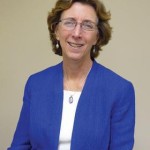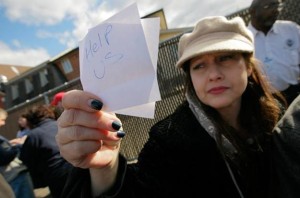The night of Sept. 5, 1996, just as Hurricane Fran made landfall on Bald Head Island, a young woman living outside of Fayetteville went into labor. Her aunt tried to drive her to the hospital — a 20 minute drive under normal circumstances. But they had to turn around. It took the emergency crew an hour to drive the four miles to the house. A couple of hours later the ambulance arrived at the hospital — they kept having to stop to clear the road with chain saws. The woman’s 7 pounds, 8 ounce son was safely born five hours later.
The National Resources Defense Council predicts that with climate change, North Carolinians will see more extreme weather like this, along with increased air pollution, heat waves, drought, and flooding.
Who suffers the most in disaster? Women.
It’s very dramatic in international disasters.1.5 times as many women than men died in the Kobe earthquake in 1995 and 3 times as many women as men died in the 2004 Asian tsunami.
But we see a similar pattern closer to home.
Evacuation plans for New Orleans before Hurricane Katrina presumed that most people had access to private transportation. But low income people — who were more likely to be women — relied on public transportation. They were stranded. More than 80% of those who were left in the city after the evacuation order were women.
The elderly typically fare far worse in disasters and women make up a higher proportion of the elderly. Sixty percent of those over age 65 in NC are women. Women who are pregnant, nursing, or who are the primary caregivers for children may have less mobility and face other difficulties in disasters. In 2003, the increased death rate due to the European heat wave was 75% higher for women than for men of all ages.
Research shows that women and children are also at greater risk of abuse after disasters. A year after Katrina, when many women were still living in temporary shelters and trailers, the rate of gender-based violence was four times higher than before the hurricane. In the six months after Hurricane Floyd in North Carolina in 1999, the rate of traumatic brain injury among children under age two increased fivefold in counties impacted by the Hurricane. Sexual exploitation may increase in areas where women have fewer options for employment.
Internationally, the situation is much worse, since women are more likely to be poor and the majority of women are providers of food and water for their families. Women who have to carry water and fuel are walking further and further in dangerous environmental conditions.
Ironically, women contribute less to climate change world-wide. Because women are more likely to be poor, we actually consume less. Those women in New Orleans without cars did not burn gasoline. Women are also more likely to be environmentally-conscious and more likely to be interested in energy efficiency. We are more likely to support green policies. And, most telling of all, >>women have greater scientific knowledge about climate change than men!
There is increasing pressure on policymakers to include gender considerations in their efforts on climate change. Some solutions are simple – having emergency contraception on hand in shelters and making sure that evacuation plans include plans to help those without private vehicles. The best way to make sure that the needs of women are considered is to include women in planning, decision-making, and implementation of programs to respond to climate change.
This is a fantastic time for women to get involved in this issue. Our optimism, resilience, and commitment to future generations are exactly what’s needed.
If you want to get more involved, here are some organizations working on issues of climate change:
- >>Women’s Environment & Development Organization. “For a just world that promotes and protects human rights, gender equality, and the integrity of the environment.”
- >>Environmental Defense Fund. An international organization, with a regional office in Raleigh. “Our work protects nature and helps people thrive by creating solutions that also carry economic benefits.”
- >>Southern Environmental Law Center. Regional organization, with offices in 6 southern states, including Chapel Hill and Asheville. “Protecting the South’s Environment through the Power of the Law.”
- >>NC Conservation Network. Statewide umbrella organization of nearly 100 environmental groups across the state working “to pass strong policies at all levels of government.”
>> Janet Colm is the founder and former CEO of Planned Parenthood of Central North Carolina. She was arrested as part of the Moral Monday protests in July 2013 and lives in Chatham County, NC.
Janet Colm is the founder and former CEO of Planned Parenthood of Central North Carolina. She was arrested as part of the Moral Monday protests in July 2013 and lives in Chatham County, NC.

There are no comments
Add yours